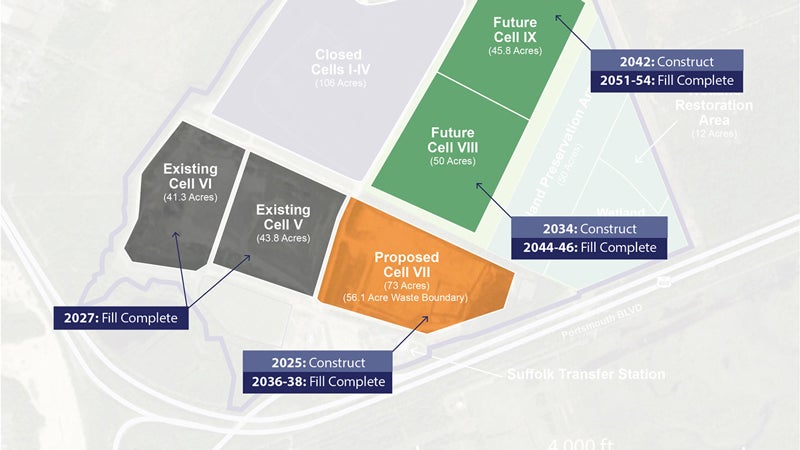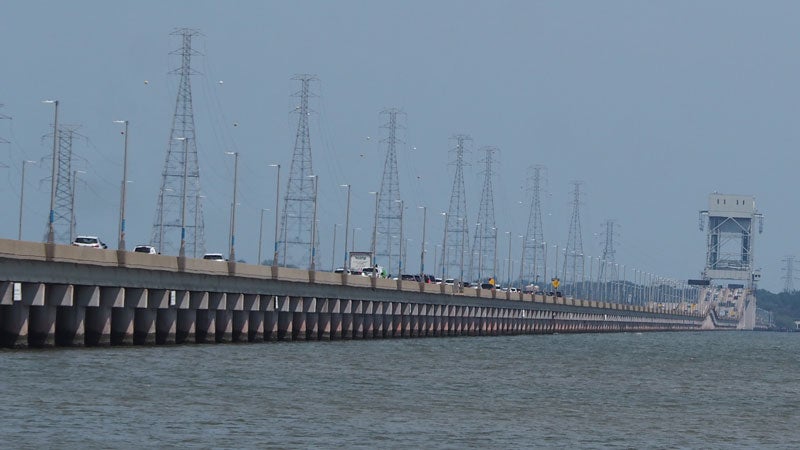SPSA prepares for full landfill
Published 3:53 pm Tuesday, April 16, 2024

- A map of SPSA’s regional landfill at Bob Feller Drive in Suffolk shows cells one through four having been closed, the 43.8-acre cell five and 41.3-acre cell six each being full by 2027, and a proposed cell seven tentatively beginning construction in 2025. (Image courtesy of SPSA)
The Suffolk landfill serving eight Hampton Roads localities, including Isle of Wight County, could reach capacity by 2027, according to projections by the Southeastern Public Service Authority, its regional governing body.
It isn’t unexpected. SPSA has known for four years that the WIN Waste, formerly Wheelabrator, waste-to-energy plant in Portsmouth where SPSA had been sending roughly 350,000 tons, or 72%, of the region’s municipal waste for incineration would shutter this June.
WIN Waste, in 2020, received word that the Navy would, by mid-2024, end its $10 million contract with the Portsmouth plant for steam to power Norfolk Naval Shipyard and instead build its own natural gas plant. WIN Waste officials, in 2020, determined the plant would be unable to stay in business through the 2027 end date of its contract with SPSA absent the Navy revenue.
“We have been anticipating this for quite some time,” said Tressa Preston, director of administration for SPSA.
WIN Waste is still accepting 1,000 tons per day from SPSA and will continue to do so until June 30, Preston said, noting SPSA has partnered with private landfills to absorb much of the tonnage formerly sent to the Portsmouth plant.
Still, the reduction of waste being processed by WIN Waste coupled with increases in tonnage interred is having an impact.
The landfill had consumed 316,266 cubic yards with 2.4 million remaining as of December 2022. By December 2023, 544,151 cubic yards had been consumed, decreasing available space to 1.8 million cubic yards.
At SPSA’s February board meeting, Executive Director Dennis Bagley noted that the life expectancy of landfill cells five and six had decreased from April 2027 to December 2026.
Bagley cited the decrease in dense ash from WIN Waste, which was being used as the landfill’s daily cover to assist with compaction, as a contributing factor. SPSA has set a target of 1,600 pounds per cubic yard as its compaction rate, and related airspace utilization factor of 0.8, both of which refer to the amount of airspace per landfill cell available once the entering garbage is compacted.
Bagley noted the February projections did not account for proposed cell cover system redesigns that he said should recapture enough airspace to meet or exceed the prior capacity date.
“We’re not at an alarming situation,” Preston said.
SPSA has also put out a request for proposals due back by May 1 for alternative waste disposal solutions to replace the Portsmouth plant.
“There should be no change in service to any member communities, including Isle of Wight,” Preston said.
In fact, the tipping fee SPSA charges its member localities is expected to drop, despite the loss of WIN Waste. Currently, SPSA charges municipalities $67 per ton, and is proposing in its 2024-25 budget to reduce the fee to $65 per ton, a change Preston attributes to SPSA’s years of planning for the Portsmouth plant’s end.
Meanwhile, plans continue for a $39 million alternative flyover roadway entrance to the Suffolk landfill, which SPSA’s board of directors agreed to build in 2021 in accordance with the city’s conditional use permit for opening a new 73-acre cell seven, according to the Suffolk News-Herald.
The Virginia Department of Transportation’s website lists an estimated sprint 2026 start date for construction of the flyover and no estimated completion date.
Preston, like Bagley, noted SPSA is also working on obtaining permits for a redesign of the site’s existing acreage to increase capacity.
“Landfilling is not the future and we want to be sustainable for as long as possible,” but “we want to have the landfill at our disposal,” Preston said.
Isle of Wight has historically accounted for just under 4% of SPSA’s regional municipal waste. Virginia Beach, the state’s most populous city, accounts for the largest share at 33%, followed by Chesapeake at 23%, Norfolk at 18%, Suffolk at 10% and Portsmouth at 9%. Franklin and Southampton County are also SPSA members and collectively account for 3% of the regional total.
Smithfield ended its curbside recycling program in 2021. Isle of Wight County also stopped recycling plastic, paper and glass at its eight municipal refuse and recycling centers in 2022, though the change so far appears to have had a negligible impact on SPSA’s regional tonnage.
Isle of Wight saw its tonnage increase from 16,883 tons in 2018 to 17,948 tons in 2021, or 6%, but was back down to 16,561 tons by 2022, according to SPSA’s past budgets. Isle of Wight is currently projected at 18,000 tons annually through 2028.
“Tonnages have gotten larger for the region in general,” Preston said.





